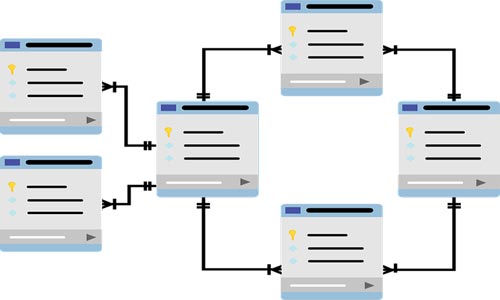Database Management System
Q:- What is Database?
Ans:- A database is an organized collection of data. It can easily managed, accessed and updated.
Q:- Define DBMS(Database Management System)?
Ans:- A Database management system(DBMS) is a software package designed to define, manipulate, retrieve and manage data in a database. A database is a collection of files, records and other objects. A DBMS is software application with interact the user. DBMS examples are Oracle, MySQL, Microsoft Access.
Q:- How many types of data can be organized?
Ans:- Data can be organized into two types:
- Flat File: Data is stored in single table
- Relational: Data is stored in multiple tables and tables are connected using a common field.
Q:- What is RDBMS (Relation Database Management System)?
Ans:- A relational database management system is a database management system that is based on the relational model as invented by E.F. Codd, of IBM’s San Jose Research Laboratory. Many Databases presently use are based on relational database model.
RDBMS information is organized in database tables, fields and records. Each RDBMS table comprises of database table columns.
Most popular RDBMS are DB2, SQL Server, MySQL and Oracle.
Q:- How to a data store in the Relational database management system?
Ans:- The data is stored in RDBMS in the form of tables. The table is a collection of related data entries and it contains columns and rows.
In Relational Database, Table is the most common and simplest form data storage
Q:- Define Tables, Columns and Record.
Ans:- Tables:– Table is set of data elements that organized using model of horizontal rows and vertical columns.
Columns:- A column is a vertical entity in a table that contains all information associated with a specific field in a table.
Record:- A record also called a row of data, is each individual entry that exists in a table. Every row in table has same structure and set of related data.
Q:- What are Null Values?
Ans:- A NULL value in a table is a value in a field that appears to be blank, which means a field with a NULL value is a field with no value.
It is important to comprehend that a NULL worth is not the same as a zero worth or a field that contains spaces.
A field with a NULL worth is one that has been left clear during record creation.
Q:- List the Data Types used in DBMS/RDBMS?
Ans:- Data Types are used to identify which types of data are going to store in the database, Datatypes is classified into five categories:-
- Numeric Types
- Alphanumeric Types
- Binary Types
- Data Time
- Other Variable types
Q:- What is the difference between Primary Key and Foreign Key?
Ans:-

| Primary Key | Foreign Key |
| A primary key uniquely identifies a record in the table. | A foreign key is a filed in the table that is a primary key in another table. |
| Primary Key can not accept null values | A foreign key can accept multiple null values. |
| We can have only one primary key in the table | We can have more than one foreign key in a table. |
Q:- Full form of these terms
(i) DDL (ii) DML (iii) SQL
Ans:- DDL – DATA DEFINITION LANGUAGE
DML – DATA MANIPULATION LANGUAGE
SQL – STRUCTURED QUERY LANGUAGE
Q:- What are DDL and DML?
Ans:- DDL – Data Definition Language(DDL) statements are used to define the database.
DDL statements are used to create and edit the structure of tables. When we execute DDL statement, its effect immediately.
Common DDL statements are CREATE, ALTER ad DROP.
DML – A data manipulation language is a language that enables users to access and manipulate data in a database. Data manipulation involves:
- Retrieval of information from the databases – SELECT statement.
- Insert a New information in Database – INSERT statement.
- Deletion of information into the database – DELETE statement
- Modification of information in database – UPDATE statement.
Q:-10 Which are the commands of DDL?
Ans:- Data Definition Language statements are used to define the database structure or schema. Some examples :
- CREATE – To Create objects in database.
- ALTER – Alters the structure of database.
- DROP – delete objects from the database
- TRUNCATE – remove all records from a table, including all spaces allocated for the records are removed.
- COMMENT – add comments to the data dictionary.
- RENAME – rename an object
Q:- Which are the command of DML?
Ans:- Data Manipulation Language (DML) statements are used for manage data within schema objects, some examples:
SELECT – retrieve data from the database.
INSERT – insert data into a table
UPDATE – updates existing data within a table
DELETE – deletes all records from a table, the space for the records remain.
MERGE – update operation (insert or update)
CALL – call a PL/SQL or Java subprogram
EXPLAIN PLAN – explain the access path to data
LOCK TABLE – Control Concurrency
Related Links –
